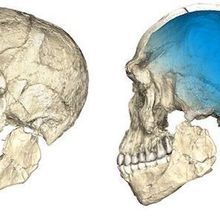Login
Subscribepaleontology, evolution

Organic Compounds Found in Martian Soil
Sukanya Charuchandra | Jun 11, 2018 | 2 min read
Researchers also found seasonal variations in atmospheric methane on the planet that may have a geological or biological origin.

New Study Contradicts Previous Idea About Origins of South Americans
Sukanya Charuchandra | Jun 1, 2018 | 2 min read
Divergent human lineages of North America intermingled before setting off to establish populations of Central and South America.

Human-Specific Genes Implicated in Brain Size
Abby Olena, PhD | May 31, 2018 | 5 min read
Three members of a gene family called NOTCH2NL may have been involved in the evolution of humans’ big cortex.

Present-Day Arboreal Birds Have Ground-Dwelling Past
Sukanya Charuchandra | May 24, 2018 | 1 min read
A mass extinction event from an asteroid hitting Earth wiped out forests and, concurrently, tree-dwelling birds.

Image of the Day: Bird Braincase
The Scientist and The Scientist Staff | May 4, 2018 | 1 min read
Newly discovered fossils shed light on the structure of the feeding apparatus of ancient seabirds.

Image of the Day: Four Eyes
The Scientist and The Scientist Staff | Apr 3, 2018 | 1 min read
Ancient monitor lizards had an extra set of “eyes” on top of their heads.

Paleoproteomics Opens a Window into the Past
Catherine Offord | Mar 1, 2018 | 10+ min read
Researchers are looking to proteins to explore the biology of ancient organisms, from medieval humans all the way back to dinosaurs.

The Weird Growth Strategy of Earth’s First Trees
Shawna Williams | Oct 24, 2017 | 3 min read
Ancient fossils reveal how woodless trees got so big: by continuously ripping apart their xylem and knitting it back together.

Mongolian Dinosaurs and the Poaching Problem
David Moscato | Sep 8, 2017 | 7 min read
High-profile cases of poached fossils shine a light on the black market for paleontological specimens—and how scientists and governments are trying to stop it.

Scientists Uncover Oldest Homo sapiens Fossils to Date
Diana Kwon | Jun 6, 2017 | 2 min read
The new fossils push the origin of the human species back by 100,000 years.

Mammalian Jaws Evolved to Chew Sideways
Catherine Offord | Jun 1, 2017 | 4 min read
Parallel evolution in jaws and teeth helped early mammals diversify their diets.

Homo naledi Likely Roamed Earth with H. sapiens
Bob Grant | May 9, 2017 | 2 min read
New research provides evidence that the ancient hominin species might not be so ancient after all.

Vision Helped Ancestral Fish Adapt to Life on Land
Diana Kwon | Mar 8, 2017 | 2 min read
“Buena vista” hypothesis suggests that changes in the sizes of eyes, rather than a shift from fins to limbs, led fish to transition to land more than 300 million years ago.

Ancient Marine Reptile Birthed Live Young
Bob Grant | Feb 15, 2017 | 1 min read
Researchers have described a pregnant Dinochephalosaurus, and the fossilized remains suggest that the massive animal did not lay eggs, as previously suspected.

Extinct River Dolphin Species Discovered
Alison F. Takemura | Aug 16, 2016 | 2 min read
Overlooked for half a century, a skull in the Smithsonian collection points to a dolphin species that lived 25 million years ago, according to a study.

Contributors
The Scientist | Aug 1, 2016 | 3 min read
Meet some of the people featured in the August 2016 issue of The Scientist.

To Retain a Brain
Karen Zusi | Jan 1, 2016 | 4 min read
Exceptional neural fossil preservation helps answer questions about ancient arthropod evolution.

A Beast from the East
Bob Grant | Dec 2, 2015 | 2 min read
Researchers unearth a dog-size, horned dinosaur from eastern North America, whose features suggest evolutionary isolation from western dinos.

Rethinking the Rise of Mammals
Bobby Bascomb | Nov 16, 2015 | 3 min read
Mammals diversified 30 million years later than previously estimated, according to a new analysis of an ancient fossil.
